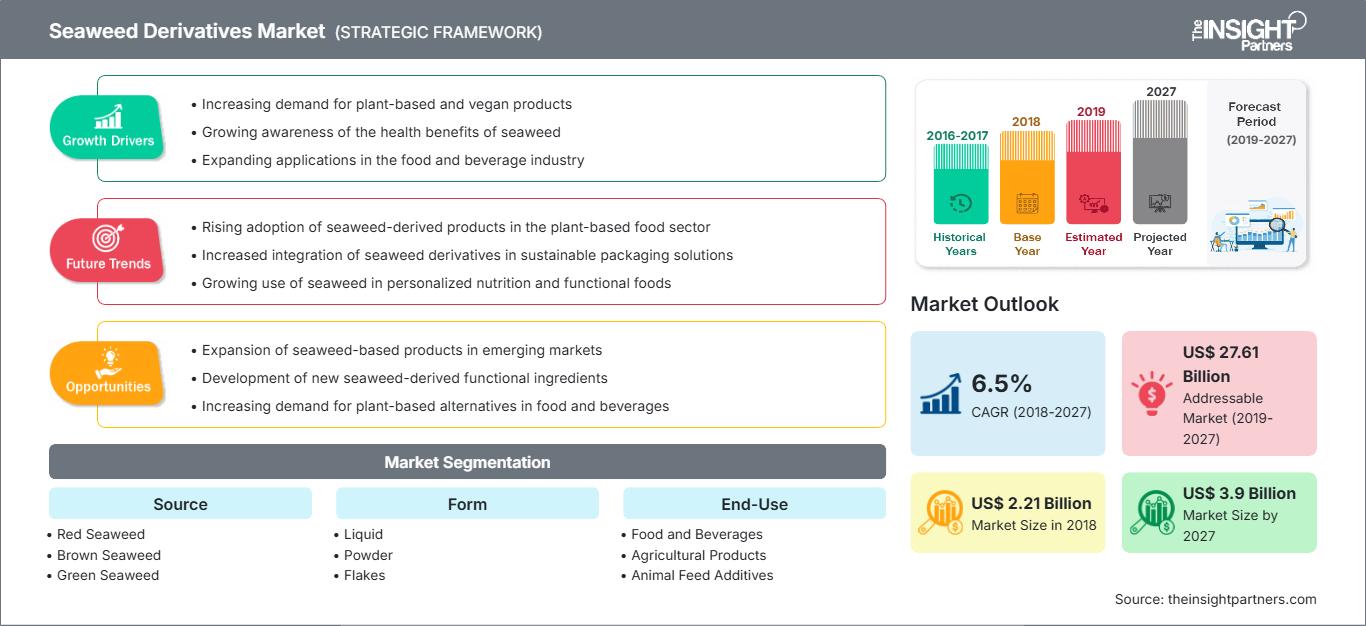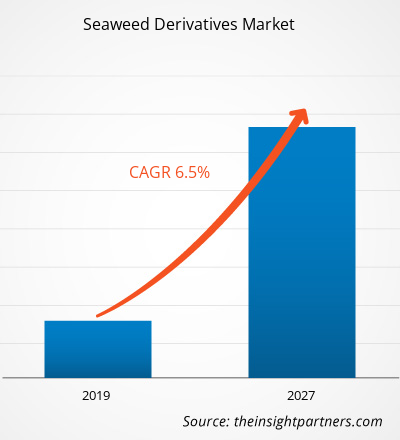Il mercato dei derivati delle alghe è stato valutato a 2.210,35 milioni di dollari nel 2018 e si prevede che raggiungerà i 3.903,91 milioni di dollari entro il 2027; si prevede una crescita a un CAGR del 6,5% dal 2019 al 2027.
Le alghe sono fondamentalmente microalghe marine rosse, brune e verdi, i cui estratti sono utilizzati nelle colture orticole per i loro effetti stimolanti la crescita delle piante. I derivati chimici delle alghe includono, tra gli altri, acidi grassi e vitamine, nutrienti minerali, fitoarmoni e polisaccaridi complessi. I principali derivati delle alghe includono alginati, carragenine e agar. Gli alginati sono in gran parte estratti dalle alghe brune, mentre carragenine e agar sono in gran parte estratti dalle alghe rosse. Alginati, carragenine e agar sono sempre più utilizzati, tra gli altri, nell'industria alimentare e delle bevande, dei mangimi e in quella agricola.
Nel 2018, l'Asia-Pacifico deteneva la quota maggiore del mercato globale dei derivati delle alghe, seguita da Europa e Nord America. La crescente domanda da parte dell'industria alimentare e delle bevande, dei mangimi e dell'agricoltura sta trainando principalmente il mercato nella regione Asia-Pacifico. Cina, Corea del Sud e Giappone sono i principali produttori e consumatori di derivati delle alghe nella regione Asia-Pacifico. Il mercato è trainato principalmente dalla più ampia applicazione dei derivati delle alghe nell'industria alimentare e delle bevande. Il loro utilizzo nei fertilizzanti è in aumento, migliorando la resa delle colture e aumentandone la resistenza ai parassiti. La crescente consapevolezza dei consumatori sui benefici per la salute dei derivati delle alghe sta dando un forte impulso al mercato delle alghe. Inoltre, la crescente domanda di prodotti alimentari biologici alimenta la crescita del mercato dei derivati delle alghe. La minore consapevolezza tra gli agricoltori riguardo all'estrazione delle alghe sta ostacolando la crescita del mercato dei derivati delle alghe.
L'epidemia di COVID-19 è iniziata a Wuhan (Cina) nel dicembre 2019 e da allora si è diffusa rapidamente in tutto il mondo. Cina, Italia, Iran, Spagna, Repubblica di Corea, Francia, Germania e Stati Uniti sono tra i paesi più colpiti in termini di casi positivi e decessi segnalati a marzo 2020. L'epidemia di COVID-19 ha colpito economie e settori in diversi paesi a causa di lockdown, divieti di viaggio e chiusure delle attività commerciali. L'industria alimentare e delle bevande globale è uno dei principali settori che ha subito gravi interruzioni, come interruzioni della catena di approvvigionamento, cancellazioni di eventi tecnologici e chiusure degli uffici a causa di questa epidemia. Ad esempio, la Cina è il polo manifatturiero globale e il principale fornitore di materie prime per vari settori. Il crollo generale del mercato dovuto al COVID-19 sta influenzando anche la crescita del mercato dei derivati delle alghe a causa della chiusura di fabbriche, ostacoli nella catena di approvvigionamento e della recessione dell'economia mondiale.
Personalizza questo rapporto in base alle tue esigenze
Potrai personalizzare gratuitamente qualsiasi rapporto, comprese parti di questo rapporto, o analisi a livello di paese, pacchetto dati Excel, oltre a usufruire di grandi offerte e sconti per start-up e università
Mercato dei derivati delle alghe: Approfondimenti strategici

-
Ottieni le principali tendenze chiave del mercato di questo rapporto.Questo campione GRATUITO includerà l'analisi dei dati, che vanno dalle tendenze di mercato alle stime e alle previsioni.
Approfondimenti di mercato
La crescente domanda da parte dell'industria alimentare e delle bevande ha favorito il mercato dei derivati delle alghe a livello globale
I derivati delle alghe come agar, alginati e carragenine sono ampiamente utilizzati in vari prodotti alimentari e bevande. Questi derivati sono utilizzati in un'ampia gamma di alimenti e bevande come gelati, sciroppi, salumi, latte artificiale per neonati, latte di mandorla, panna montata, barrette di cioccolato, latte al cioccolato, bevande al caffè (ad esempio, caffè freddo e bevande al caffè a base di soia), panna da caffè, ricotta, yogurt, formaggio fresco e panna acida, tra gli altri. Le carragenine sono utilizzate come ingrediente addensante in budini, latte al cioccolato, gomme da masticare, marmellate e gelatine. Inoltre, le carragenine riducono gli sprechi prolungando la durata di conservazione degli alimenti senza alcuna perdita di qualità. Diversi alimenti, come la maionese e il condimento per insalata, si separerebbero senza l'aiuto di uno stabilizzante. Pertanto, la carragenina viene utilizzata come agente stabilizzante nella maionese e nel condimento per insalata. Pertanto, l'ampia gamma di applicazioni dei derivati delle alghe nell'industria alimentare e delle bevande stimola la crescita del mercato globale dei derivati delle alghe.
Approfondimenti sulle fonti
In base alla fonte, il mercato dei derivati delle alghe è segmentato in alghe rosse, alghe brune e alghe verdi. Nel 2018, il segmento delle alghe rosse ha rappresentato la quota maggiore del mercato globale dei derivati delle alghe. Le alghe rosse tendono ad avere i livelli proteici più elevati, responsabili del loro colore rosso. Nonostante si trovino in acque poco profonde, le alghe rosse sono in grado di resistere a acque profonde e condizioni di scarsa illuminazione. Questi fattori stimolano la crescita del mercato dei derivati delle alghe rosse.
FormInsights
In base alla forma, il mercato dei derivati delle alghe è segmentato in liquidi, in polvere e in scaglie. Nel 2018, il segmento liquido ha rappresentato la quota maggiore del mercato globale dei derivati delle alghe; tuttavia, si prevede che il segmento in polvere registrerà il tasso di crescita più rapido durante il periodo di previsione. I derivati liquidi delle alghe brune sono commercializzati per l'uso in orticoltura e agricoltura. I derivati liquidi delle alghe vengono utilizzati ad alti tassi di diluizione, il che si traduce in quantità minime di materiale applicate nell'area interessata. I principi attivi presenti nei derivati liquidi delle alghe sono in grado di influenzare temperature così basse.
Approfondimenti sull'uso finale
In base all'uso finale, il mercato dei derivati delle alghe è segmentato in alimenti e bevande, prodotti agricoli, additivi per mangimi, prodotti farmaceutici e altri. Nel 2018, il segmento degli alimenti e delle bevande ha rappresentato la quota maggiore del mercato globale dei derivati delle alghe; tuttavia, si prevede che il segmento degli additivi per mangimi registrerà il tasso di crescita più rapido durante il periodo di previsione. I derivati delle alghe, come gli alginati, sono ampiamente utilizzati in prodotti da forno, caramelle, latticini, condimenti per insalate, gelati, creme e gelatine, nonché in salsicce, carni lavorate e pesce. Vengono utilizzati anche per chiarificare birre e vini. Gli alginati sono completamente biologici e sono una sostanza sicura per l'applicazione alimentare. Inoltre, gli alginati sono in grado di addensare una soluzione quando vengono sciolti in acqua. Inoltre, gli alginati possono formare gel se aggiunti a una soluzione di sali di calcio. Per questo motivo, gli alginati sono utilizzati principalmente nei condimenti per insalata e nella maionese.
Mercato dei derivati delle algheLe tendenze regionali e i fattori che influenzano il mercato dei derivati delle alghe durante il periodo di previsione sono stati ampiamente spiegati dagli analisti di The Insight Partners. Questa sezione illustra anche i segmenti e la geografia del mercato dei derivati delle alghe in Nord America, Europa, Asia-Pacifico, Medio Oriente e Africa, America meridionale e centrale.
Ambito del rapporto di mercato sui derivati delle alghe
| Attributo del rapporto | Dettagli |
|---|---|
| Dimensioni del mercato in 2018 | US$ 2.21 Billion |
| Dimensioni del mercato per 2027 | US$ 3.9 Billion |
| CAGR globale (2018 - 2027) | 6.5% |
| Dati storici | 2016-2017 |
| Periodo di previsione | 2019-2027 |
| Segmenti coperti |
By Fonte
|
| Regioni e paesi coperti |
Nord America
|
| Leader di mercato e profili aziendali chiave |
|
Densità degli operatori del mercato dei derivati delle alghe: comprendere il suo impatto sulle dinamiche aziendali
Il mercato dei derivati delle alghe è in rapida crescita, trainato dalla crescente domanda da parte degli utenti finali, dovuta a fattori quali l'evoluzione delle preferenze dei consumatori, i progressi tecnologici e una maggiore consapevolezza dei benefici del prodotto. Con l'aumento della domanda, le aziende stanno ampliando la propria offerta, innovando per soddisfare le esigenze dei consumatori e sfruttando le tendenze emergenti, alimentando ulteriormente la crescita del mercato.

- Ottieni il Mercato dei derivati delle alghe Panoramica dei principali attori chiave
Mercato globale dei derivati delle alghe - Per fonte
- Alghe rosse
- Alghe brune
- Alghe verdi
Mercato globale dei derivati delle alghe - Per forma
- Liquido
- Polvere
- Fiocchi
Mercato globale dei DERIVATI DELLE ALGHE - Per uso finale
- Alimenti e bevande
- Prodotti agricoli
- Additivi per mangimi
- Prodotti farmaceutici
- Altro uso finale
Profili aziendali
- W Hydrocolloids, Inc.
- KIMICA Corporation
- DuPont de Nemours, Inc.
- Gelymar SA
- CP Kelco
- ALGAIA
- Compaña Española de Algas Marinas, SA
- Cargill, Incorporated
- ARTHUR BRANWELL & CO
- AGARMEX, SA DE CV
- Analisi storica (2 anni), anno base, previsione (7 anni) con CAGR
- Analisi PEST e SWOT
- Valore/volume delle dimensioni del mercato - Globale, Regionale, Nazionale
- Industria e panorama competitivo
- Set di dati Excel
Report recenti
Testimonianze
Motivo dell'acquisto
- Processo decisionale informato
- Comprensione delle dinamiche di mercato
- Analisi competitiva
- Analisi dei clienti
- Previsioni di mercato
- Mitigazione del rischio
- Pianificazione strategica
- Giustificazione degli investimenti
- Identificazione dei mercati emergenti
- Miglioramento delle strategie di marketing
- Aumento dell'efficienza operativa
- Allineamento alle tendenze normative






















 Ottieni un campione gratuito per - Mercato dei derivati delle alghe
Ottieni un campione gratuito per - Mercato dei derivati delle alghe